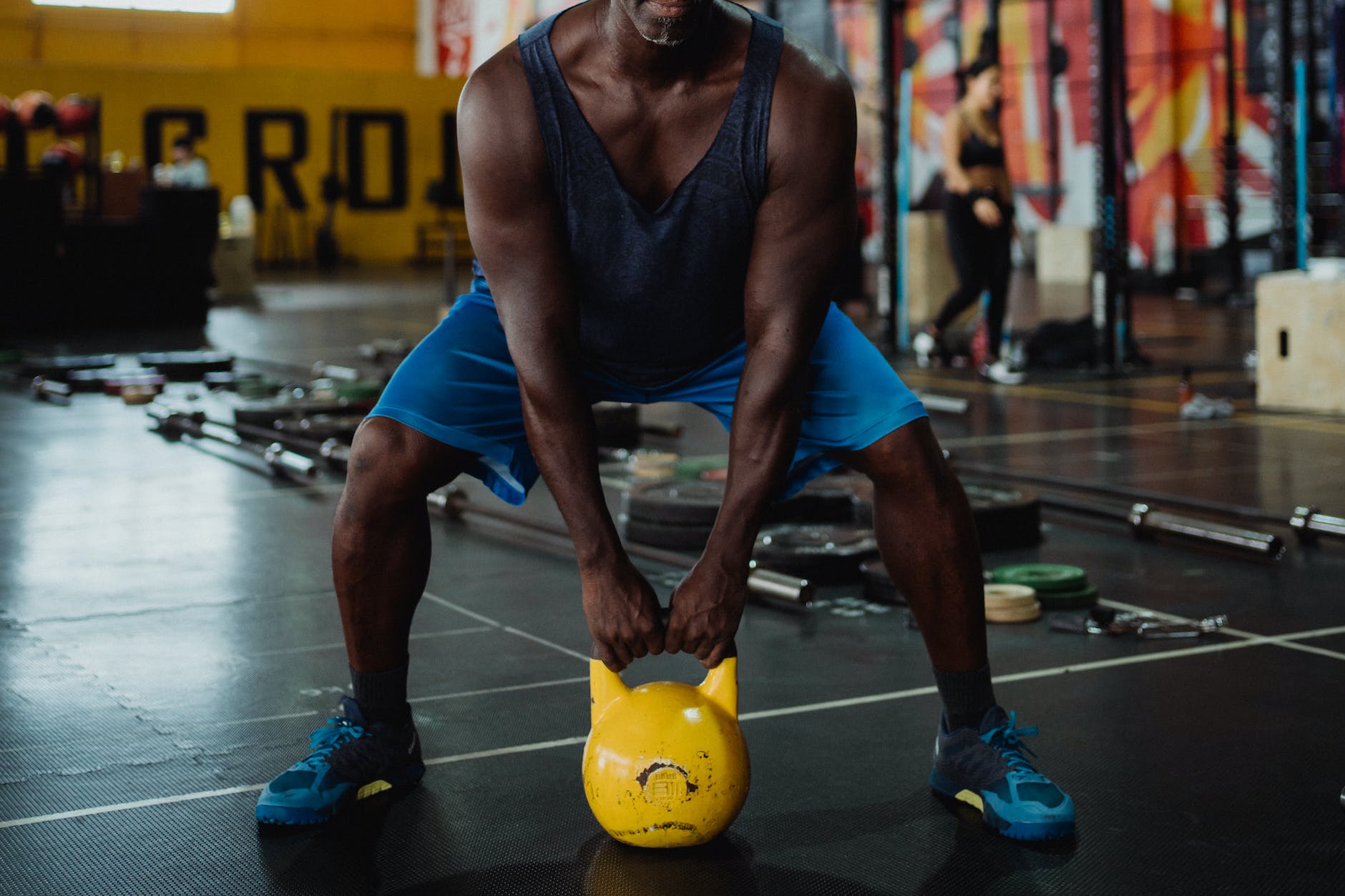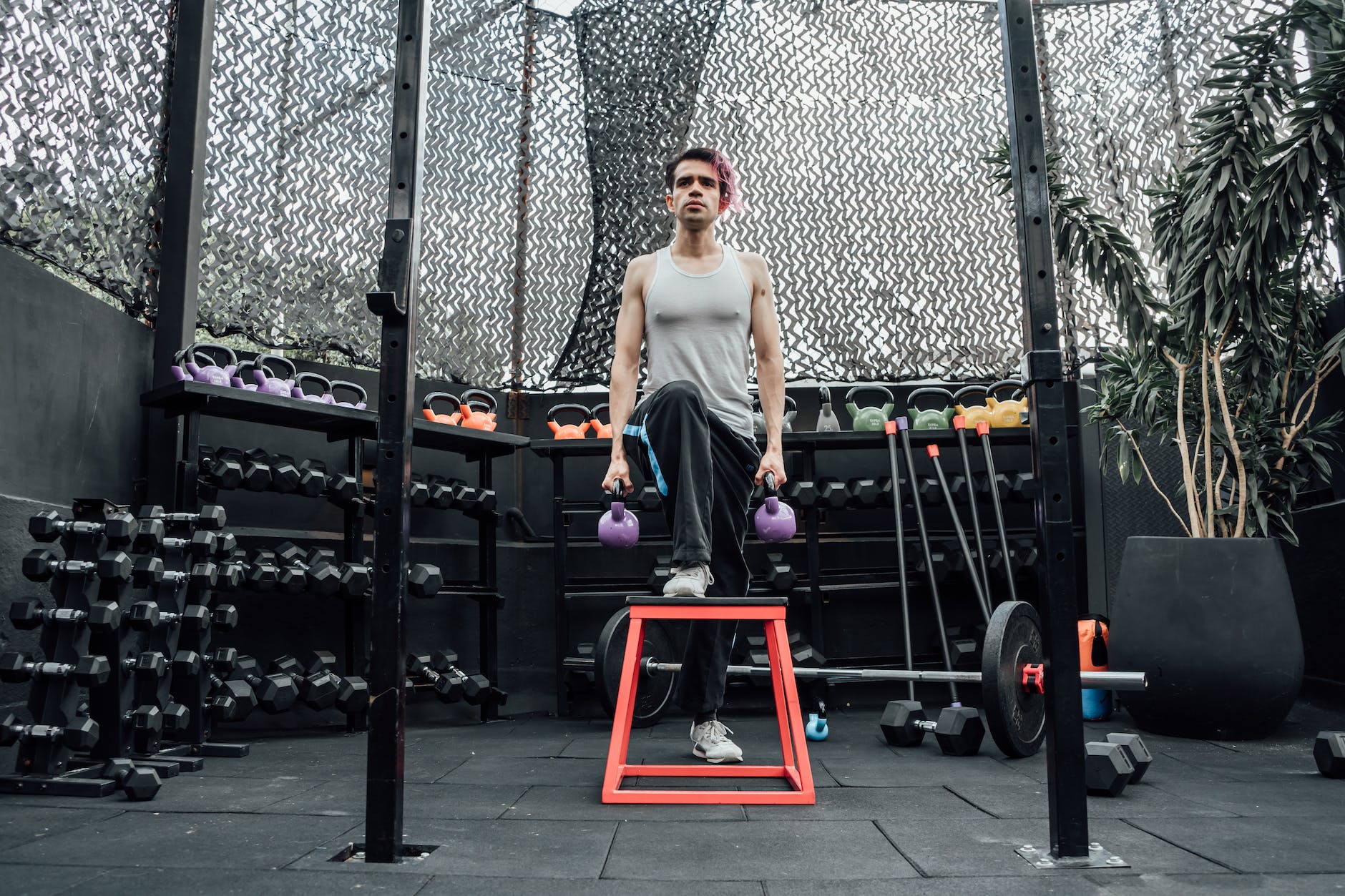We have some more kettlebell exercises on our list for you to try. Read on.
Perform 1 – 3 sets of 12 – 15 reps of all these movements.
Click Here to Read Part 1 of Kettlebell Exercises
Squat Sumo
The sumo squat is one of those squat variations that work well with kettlebells because they assist you in keeping the weight centered, allowing appropriate form and targeting the right muscles, specifically the glutes, and quads.
This movement, appropriately dubbed the sumo squat, shifts from the conventional slightly wider-than-hip-width stance to a more dramatically wide posture, comparable to a sumo wrestler.
- Hold a kettlebell at chest height in cupped hands or between your legs.
- Stand with your feet 8 to 12 inches with your toes pointed out at a 45-degree angle. Your thigh bones should be turned at the same angle as your feet.
- Inhale and drop into a squat stance by hinging your hips back and bending your knees. Maintain a braced core and a neutral spine position. Your knees should be parallel to your toes on both sides.
- Exhale, then push through your feet, engage your glutes, and reverse the motion to return to the beginning position.

Deadlift Sumo
The sumo deadlift, another sumo stance-based variation of a popular compound lift, lends itself well to the usage of a kettlebell as well. Sumo deadlifts put less strain on the lower back, making them a good choice for novices or anyone suffering from lower back tightness.
Glutes, adductors, hamstrings, quadriceps, back, core, and calves will be worked by sumo deadlifts. The glutes, adductors, and hamstrings will be worked harder than in a traditional deadlift.
- Stand with your feet about 8 – 12 inches apart and turn outward slightly. The kettlebell should be placed beneath your hips.
- Brace your core, inhale, and begin to bend your knees such that they are parallel to your shins. Hinge your hips back while keeping your chest straight and your spine neutral.
- Using an overhand hold, grasp the kettlebell with both hands. Pull up to engage your lats and legs by locking your shoulder blades down and back.
- Begin by pushing through your feet, pushing your legs into the floor, and raising your legs upward. As you hoist the kettlebell, your arms should be close to your body.
- Raise your hips to full extension, then squeeze your glutes. With the kettlebell between your legs, exhale at the peak.
- Slowly lower back down, reversing the motion to the starting position while keeping an engaged core and a neutral spine.
Walking Kettlebell Lunge
Any sort of lunge can be performed with a kettlebell instead of a dumbbell, but the walking lunge is an excellent choice with kettlebells since they swing and challenge your balance in unexpected ways. Walking lunges will engage your quadriceps, glutes, hamstrings, calves, and core.
- Stand with an upright posture and a braced core, holding a kettlebell in each hand and your feet about hip-width apart. Hold a kettlebell in the racked or goblet position as an alternative.
- With your right foot, take a two-foot step forward.
- Lower your left (back) knee by bending your knees towards the floor while keeping your core supported. Stop lowering your knee right before it contacts the ground. Have your front thigh parallel to the floor.
- Push through your right (front) foot and lift your left foot off the floor in a fluid motion to bring it to the center, then step it in front of you.
- Alternate steps, moving forward with each lunge. Move slowly and with control, defying gravity and maintaining your balance.
- On the last rep, bring your feet together in the center and stand upright.
Wall Sit with Kettlebells
Wall sits are an isometric workout that tests your quadriceps, glutes, and calves’ muscular endurance and strength. Isometric workouts, which include static holds such as the wall sit, are extremely effective strength builders.
In a cupped goblet position, hold a kettlebell at chest height.
Place your back against a wall; feet shoulder-width apart and roughly 2 feet away from the wall.
Brace your core and slowly glide down by bending your knees to 90 degrees. Your feet should be higher than your ankles and have your shins perpendicular to the floor.
Maintain your stance by pressing your back flat against the wall for 20 to 60 seconds.
Slide your back slowly up the wall to the starting position.

Step-Up using Kettlebells
Step-ups work your quads, glutes, and hamstrings while also testing your stability, coordination, and balance. Because kettlebells naturally dangle and swing somewhat during movement, using one instead of a dumbbell doubles the strain on your core muscles. To counteract this increased movement, you will need to engage more stabilizing and deep core muscles.
For the step-up, you can use one or two kettlebells. If you only have one kettlebell, complete all of the steps on one side before going on to the other. You may do the same thing with two kettlebells or alternate sides with each step.
- Holding a pair of kettlebells, stand in front of a bench, step, plyo box, and stair.
- You have kettlebells at your sides. Use a single kettlebell on one side instead of both.
- Step up onto the bench or a box with your right foot by pushing into your right heel and glute and elevating your leg to straighten it.
- Squeeze your glutes and lift your left foot up to meet your right foot on the bench.
- Bend your right knee and take a stride back with your left foot, bringing your right foot down to the floor.
To Conclude
This kettlebell leg exercises includes moves that use the kickstand position, which you may not have done before. The kickstand position requires you to stagger your feet so that one foot is 6-12 inches in front of the other. It allows you to work on single-leg strength and stability while also challenging your core and serving as a wonderful stepping stone to exercises that need even more balance.
A lot of times, people go straight into a single-leg deadlift and run into technique issues or feel it more in their lower back. Single-leg training is very challenging, and starting with a kickstand helps to provide more pelvic control and build strength without losing form.
Are you willing add some intensity to some of these kettlebell exercises? Pick up a medium-weight bell. Begin with a weight that allows you to do 12 to 15 reps without losing form; the weight should be challenging but not too light.
People are often afraid to go heavy, but the word heavy is relative; you want to challenge yourself while still maintaining good technique. So get started on this kettlebell leg exercises – you’ll feel it tomorrow.
